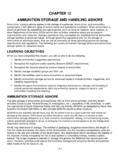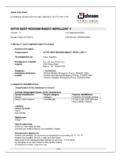Transcription of By The Association of Home Appliance Manufacturers The ...
1 Safe Servicing of Household appliances with flammable Refrigerants: Recommended Practices By AHAM The Association of home Appliance Manufacturers The information in this brochure was developed by representatives of Appliance Manufacturers , in conjunction with some of their chemical suppliers. These Recommended Practices were developed by the members of AHAM September, 2017 2 Table of Contents Introduction .. 3 Common flammable Refrigerants (chart) .. 4 Recommended Procedures for Safe handling and Servicing of appliances with flammable Refrigerants .. 5 Service Procedures.
2 5 Pre-service Safety Check .. 5 Leak Detection and Coolant-Line Repair .. 6 Recharging or Replacing Refrigerant .. 7 Refrigerant Removal .. 8 After Servicing .. 9 Disposal of appliances Containing flammable Refrigerants .. 10 Storage of flammable Refrigerant Cylinders .. 10 Transport of flammable Refrigerant Cylinders .. 11 Final Note .. 12 3 Introduction The Manufacturers of cold appliances ( household refrigerator and freezers, ice makers, beverage coolers, room and portable air conditioners, and dehumidifiers), represented by the Association of home Appliance Manufacturers (AHAM), provide the following recommended safety procedures and information for technicians servicing appliances with flammable refrigerants classified as A2, A2L, or A3 in customers homes.
3 This refrigerant nomenclature is found in American Society of Heating, Refrigeration, Air Conditioning Engineers (ASHRAE) Standard 34-2016, Designation and Safety Classification of Refrigerants. The home Appliance industry has begun to produce cold products that use these new flammable refrigerants as part of its continuing effort to manufacture the most energy efficient, environmentally friendly products. These refrigerants have been adopted, at least in part, due to regulatory changes that will phase-out legacy refrigerants. These new alternatives include A3 refrigerants, such as R-600a and R-290 and A2L refrigerants, such as R-32 and R-452B, which have been safely and widely used for many years in home appliances sold in Europe and Asia.
4 1, 2 These substances include, for example, isobutane, which have been safely used as a propellant in cosmetics and personal care products. Of the 100 million household refrigerators and freezers manufactured globally every year, roughly one-third or more use isobutane (R-600a) or a similar refrigerant. These newer substances have lower global warming potential, however, they are flammable . Thus, precautions are necessary to mitigate the associated fire and explosion hazards related to the higher flammability of these new refrigerants that generally do not contain a special odorant as would be found with heating or cooking propane or natural gas.
5 For this reason, the home Appliance industry recognizes the importance of following the recommended safety procedures when a service provider is working with or around appliances with these refrigerants in order to reduce the risk of fire or explosion. This guidance does not attempt to be comprehensive and does not substitute for manufacturer specific instructions, applicable safety standards, or federal, provincial, state or local regulations. Further, this guidance is in addition to the special product labeling and use conditions required by federal law and developed by industry stakeholders to help ensure such refrigerants can be safely used in the home .
6 1 Refrigerants used in the United States are subject to approval by the Environmental Protection Agency under the Significant New Alternatives Policy (SNAP). See Rules 17, 19, and 21 and any other applicable rules at Canadian laws and regulations do not specifically permit certain refrigerants, but rather prohibit or restrict the use of certain substances. For example, the Ozone-depleting Substances Regulation controls the import, export, manufacture, use and sale of ozone depleting substances. 2 Note: This document does not provide guidance on the use of Ammonia as a refrigerant compound.
7 Ammonia is a SNAP approved material, but is not commonly found in household appliances produced in the last 25 years. 4 Notice: appliances that use one of these special refrigerants, such as R-600a (isobutane), R-290 (propane), R-32, or R-452B, will be marked with a specific symbol that notifies the servicer of the presence of these refrigerants. A service provider should review this marking and follow all instructions from the original equipment manufacturer. appliances that use A2L or A3 refrigerants will be marked with this label. This chart lists the more common flammable refrigerants found in household appliances as of 2017.
8 Refrigerant ASHRAE 34 Classification Status of Flammability Required to be Captured or May Be Released R-32 A2L flammable Must be recaptured R-452B A2L flammable R-600a A3 flammable May be R-290 A3 flammable 4 3 Refer to for other acceptable refrigerants (the lists on the SNAP website include the ASHRAE 34 safety classification where available). 4 Within Canada, all three levels of government (federal, provincial, and municipal) contribute to environmental protection and have a role with respect to hazardous waste and hazardous recyclable material.
9 Refrigerants may be subject to regulation under the Canadian Environmental Protection Act or various other provincial and municipal requirements. 5 Recommended Procedures for Safe handling and Servicing of appliances with flammable Refrigerants (A2, A2L, or A3) according to ASHRAE Standard 34) Service Procedures Pre-service Safety Check 1. Check the data plate or label on the compressor to determine which refrigerant is used. Look for the presence of red color process tubing. 2. Use a combustible gas leak detector to perform a background check around the Appliance .
10 CAUTION: To avoid a risk of injury, do NOT use leak detectors with an arc or spark module to check for leaks in and around appliances that use A2L or A3 refrigerants. Technicians must be trained in the use, and the device must be certified for use with the specific refrigerant class being serviced. If flammable refrigerant is detected, immediately ventilate the room, evacuate the area, and notify the owner or customer. Recheck with a combustible gas leak detector before proceeding. 3. Review the Safety Data Sheet (SDS) for the refrigerant listed on the Appliance s compressor.




